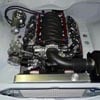-Crank Fitting-
Time to fit the crank permanently...
First we need to give it a good clean.

Use some carby cleaner and a rag...

As well as some bottle brushes, Give all the oil holes a good clean out. look down each hole and make sure there is not grit or anything at all in the tunnels.

So make sure the thing is spotless.

Do the same for the main journals of the block, remember cleanliness is next godliness... or something like that.

Give each bearing a wipe over with the carby cleaner and a rag and then wipe dry with a clean section of rag and fit the lower bearings to the block (ones with the holes)

Rub some assembly lube onto the bearings (Engine oil is ok, but Assembly lube is better)

Put some assembly lube on both sides of the thrust bearings and sit them in the block... Sorry I forgot to take a pic of where they sit but you will see in the next few pics... They are fitted with the slots facing towards the crank.

Then put assembly lube on the mains and the faces where the thrust washers slide on the crank

Drop the crank into the block... Carefully
Sometimes when you put the crank in the thrust washers will move around a little, Mine ended up like this

Not a problem tho, just push them back down so they are flush with the block like this.

Time to check end float (I should have done this when I first test fit the crank but forgot... tisk tisk)
End float is how much the crank can move forward or back and is controlled by the thrust bearings. There is 2 ways to check it... With a dial gauge or a simple feeler gauge. Ill show you the dial gauge first.
Setup the Dial Gauge onto the front of the block, making sure the gauge is straight and parallel to the crank and the pointer is either on the front of the crank or on one of the counterweights

Lever the crank to the rear as far as possible

Zero the gauge

Lever the crank forward

Then check how far the gauge has moved... in this case 0.004" (4 Thou) Acceptable range is 0.0024" to 0.0099"

Or simply lever the crank either forward or back and then slide a feeler gauge between the thrust bearing and crank, 0.004" feeler gauge just fit.

Then clean all the main caps using the same methods as above.

Clean and fit the solid bearing halves.

Apply some assembly lube onto the bearings

Give the main bolts a good clean, make sure the threads are spotless.

Apply engine oil to the threads and the underside of the bolt head.

Sit the caps over the crank onto the block, Start the bolts into the thread a few turns and you will notice the caps are sitting up a little.

Dont pull it down flush with the bolts, Give them a tap with the butt of a hammer.

And make sure its sitting flush like this

Cant remember if the G-series are the same but on the 4z's you need to apply a little bit of sealant to the areas with the blue box's on the very last main cap. Make sure you clean the faces and matching faces on the block first.

Thread all the bolts in by hand, making sure you don't feel any resistance. They should go in easily, Then Torque them all in 3 stages. 30nm, 60nm and 100nm each time in the right sequence.
You should see some sealant ooze out from the rear main cap where you applied sealer.

And done, Crank is now fitted... Give it a spin and it should rotate easily by hand and have no tight spots... If it feels tight at all then there is either some foreign material between the bearings or your clearances are not right.
If you did your earlier checks and kept everything clean there should be a problem. Job done

Fitting Pistons/Rods is next, Stay tuned













